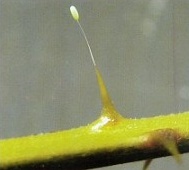Lacewings, Antlions & Mantidflies (Order: Neuroptera)

Adult lacewings (like this Chrysopa perla) are major predators of aphids.
Photograph by Algirdas.
This is one of the most primitive insect Orders among those that show complete metamorphosis (i.e. whose development stages are egg, larva, pupa and adult). The order contains about 4,000 species and there is considerable diversity within the Order.
In general, adults of the order Neuroptera have two pairs of membranous wings, with an extensive pattern of veins and cross-veins. At rest, their wings are folded flat over the abdomen, or held tent-like over the body.
They have biting mouthparts and are predators on small insects and other arthropods. Lacewings, in particular, are regarded as the gardener's friend, as both the adult and larval forms eat aphids.
The name Neuroptera comes from the Greek neuron (nerve) and pteron (wing) and refers to the nerve-like network of veins on the wings of these insects. This term was originally used by Carl von Linnaeus to include dragonflies and damselflies as well as the current Neuroptera.
Originally the Order Neuroptera was much larger and contained several sub-orders. However, entomologists have now split the Order Neuroptera into three Orders:
- Megaloptera - Alderflies, Dobsonflies & Fishflies
- Neuroptera - Lacewings, Antlions & Mantidflies
- Raphidioptera - Snakeflies
Immature stages
The immature stages of the lacewings and antlions have some quirky features.
The larvae have specialised mouthparts with large jaws that interlock to form pincers. Once impaled on these pincers, a prey's body contents are sucked out through hollow food channels running between the jaws.
The larvae do not have a complete digestive system: the gut is a dead end, where waste accumulates throughout development. It is only expelled when the gut joins up with the anus, near the end of the pupal stage.
When they pupate, lacewing and antlion larvae dig a small cavity in the soil and spin a loose cocoon around themselves. But whilst other insects that do this produce silk for their cocoons in modified salivary glands and spin it with their mouths, the neuropterans produce it in their excretory organs (Malpighian tubules) and spin the cocoons from their anus. Only one other order, the Coleoptera (beetles) makes silk in this way.
Lacewings (Chrysopidae)
The most familiar of the lacewings are the green lacewings in the family Chrysopidae, which has around 15 British species. One interesting fact is that some species of lacewings can detect bats using hearing apparatus in their wings.
Some lacewings disguise their eggs by placing them on top of a slender stalk secreted by the female's reproductive system. Biologists initially thought these eggs were fruiting bodies of a fungus called Ascophora ovalis. But in 1737 Rene Reaumur, a French scientist, discovered that they were in fact lacewing eggs.

The egg of a lacewing on top of its slender stalk
Lacewing larvae are usually found in vegetation where they typically feed on aphids, mites, and scale insects. Some species are reared and sold commercially to gardeners as biological control agents. Some lacewing larvae camouflage themselves by attaching the dead bodies of their prey, or bits of bark or moss, to spines on their back.

Lacewing larva (Chrysopa sp.) feeding on whitefly. Photograph by Jack Dykinga, USDA
Antlions (Myrmeleontidae)
Adult antlions look a little like dragonflies but their wing pattern is different, they have longer, clubbed antennae and they are feeble fliers.
Antlions are sometimes called doodlebugs in the US, because of the 'doodles' made in sand by their larvae. Antlion larvae live in the soil and construct pitfall traps to snare prey. They are popular with children in the US because of their 'fun' lifestyle of trapping any insects that come near their pit.
Where to find them
Using a beating tray or a sweep net can be effective, especially near water if you're looking for adult alderflies. Snakeflies can be found on oak and pine trees in the summer, although they are not common insects, and few species occur in the UK. Adult alderflies (two species in the UK, three in Europe) are usually found in spring and early summer.
There are 14 species of the familiar green lacewings in Britain, and these sometimes come to house lights or to moth light traps.
Most antlions fly at night - there are only a few species north of the tropics, but if you know of an area where they can be found, examining the ground for their little trap sites can be productive. There is only one species of antlion that occurs in the UK (Euroleon nostras) and it is only found in one location in Suffolk.
Essential reading from the Amateur Entomologists' Society
A to Z of insects
- Alderflies
- Ants
- Antlions
- Archaeognatha
- Barklice
- Bees
- Beetles
- Biting lice
- Booklice
- Butterflies
- Bugs
- Caddisflies
- Cockroaches
- Crickets
- Damselflies
- Dobsonflies
- Dragonflies
- Earwigs
- Fleas
- Flies
- Grasshoppers
- Lacewings
- Leaf insects
- Lice
- Mantids
- Mayflies
- Moths
- Praying Mantids
- Scorpionflies
- Snakeflies
- Stick insects
- Stoneflies
- Strepsipterans
- Sucking lice
- Termites
- Three-pronged bristletails
- Thrips
- True Bugs
- Wasps
- Web-spinners
- Zorapterans
- Non-insect hexapods
- Proturans
- Springtails
- Two-pronged bristletails
Back to Insect Orders.
![Amateur Entomologists' Society home page [Logo]](/images/aes-logo-wplant.gif)